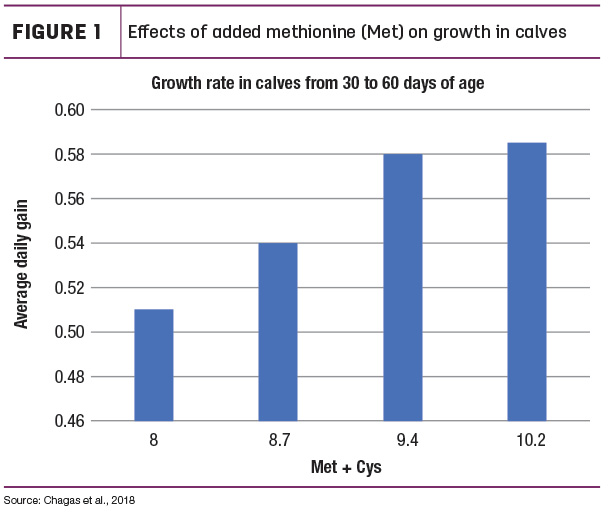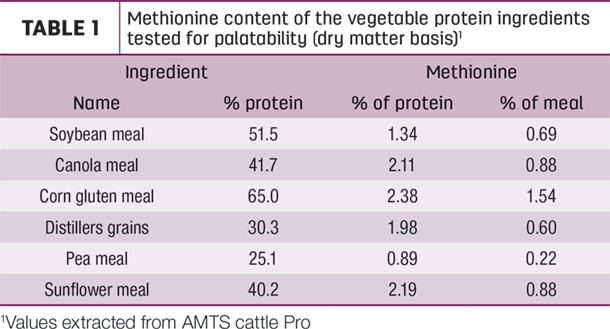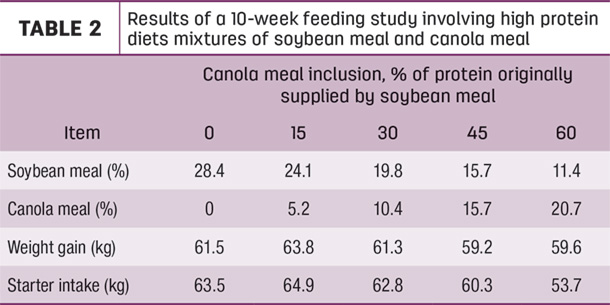

May 2022
This article was first published at Progressive Dairy Canada.
Many on-farm management factors are important for the development of healthy, productive heifers and among them are the consumption of nutrients preweaning. Research regarding the preweaned calf remains largely focused on health and rumen development. A third topic is emerging, and that revolves around the provision of protein and amino acids.
There remains a lack of information regarding protein during the starter period and even less on amino acid requirements. While milk is the perfect food, generally milk replacers mimic the composition of milk, and the starter diet is intended to be appetizing to help accustom calves to eating solid feed. However, there are several studies that indicate that a bit more focus in this area can pay rewards with respect to growth, survival and possibly even productive longevity.
A pivotal study spearheaded by the amino acid expert Dr. Chuck Schwab clearly indicated that methionine might be limiting in typical calf diets. In this study, calves received 1.13 kilograms of whole milk per day for the first four weeks of life. The researchers infused varying amounts of amino acids directly into the true stomach of test calves, allowing them to accurately calculate the nutrient supply. The results revealed that the amino acid methionine limited growth and protein retention.
Usually starter feed is provided prior to weaning and continued after weaning. Once weaned, the calf, like the cow, must rely on rumen microbial protein and escape amino acids to allow growth. There is often a check in growth rate at weaning. Two additional major studies showed that methionine is the first limiting amino acid for weaned calves given a corn-soybean-meal diet.
A more recent experiment confirmed methionine as being a limiting amino acid for calves. Researchers in Brazil conducted a trial reminiscent of the one reported by Schwab. Calves in this trial received 1 kilogram of milk replacer per day. No starter feed was provided so that methionine could be accurately evaluated. The total methionine plus cysteine (met+cys) in the diet was reported, but only methionine was added to modify the supply. Results were not clear-cut for the first 30 days of life. When tested from 30 to 60 days, there was an advantage in growth for the calves that received supplemental methionine (Figure 1).

Bear in mind, calves were limited to 1 kilogram of milk replacer per day. The added growth indicates that the level of methionine alone was responsible for the additional growth in these calves.
Clearly, methionine is an amino acid that can limit growth in calves with typical 18% protein starter diets. While gain is important, it may be secondary to health. There is additional research support for the role of methionine in supporting calf health.
The most common base ingredients used in calf starter feeds in North America are corn and soybean meal. These ingredients have been chosen not only because they are readily available, but also out of concern for palatability of the starter diet for calves. A large and elaborate experiment conducted in Spain showed that calves preferred wheat and barley as the major energy sources. Calves also overwhelmingly preferred soybean meal over corn gluten meal, rapeseed meal (a meal similar to canola meal), distillers grains, peas and sunflower meal. Rapeseed meal was preferred over corn gluten meal, distillers grains and pea meal. Corn gluten meal was the least-preferred protein.
As Table 1 shows, these ingredients provide varying amounts of methionine. Soybean meal is clearly an ingredient that is limiting in this nutrient.

Mixing protein ingredients
A very recent experiment conducted jointly between the University of Saskatchewan and the University of Agriculture in Krakow compared starter diets where the primary protein source was provided by either soybean meal or canola meal. Important to note is that methionine was added to both high-protein supplements. As expected, preweaning starter intake was less with the canola meal diet, although there were no differences in the post-weaning period. Of particular importance, however, were the effects on intestinal tract development. The average number of days with diarrhea were 6.9 and 5.9 for the soybean meal and canola meal diets, respectively. Importantly, the canola meal diet was associated with greater intestinal development by calves. Are there ways of including alternatives to soybean meal that might lead to better gut health?
Hadam et al. explored the possibility of mixing soybean meal and canola meal. Calves were offered high crude protein starter diets formulated to provide the same amount of protein supplied by either 24% soybean meal (diet 1), 12.5% soybean meal plus 16.5% canola meal (diet 2) or 35% canola meal (diet 3). There were no differences in frequency of eating, rate of eating or the amount of starter feed consumed between diet 1 and diet 2, indicating that calves consumed the mixture as well as the soybean-meal-only diet (diet 1).
A newer study investigated supplying varying amounts of canola meal in very high protein (24%) starter diets. With such high protein levels, it is likely that methionine was not in short supply. Weight gains over the course of the 10-week-long study were similar for all diets. Starter intake, however, declined at the highest level of canola meal inclusion (Table 2).

Why supply a mixture of vegetable proteins? Soybean meal is preferred by calves over other vegetable proteins, based on palatability. However, preparing starter diets with a mixture of soybean meal and another vegetable protein such as canola meal can be helpful in providing greater quantities of methionine to calves and may allow diets with less overall protein to be formulated.
Mixing vegetable proteins may also improve gut development. In these feeding experiments, calves were maintained under highly controlled conditions, and morbidity was low. Such conditions are not achievable under normal housing and management conditions on farms. Improved gut development can help calves to better withstand on-farm stresses and potentially reduce the prevalence of gut health issues.
This article was funded through the AgriMarketing Program under the Canadian Agricultural Partnership.